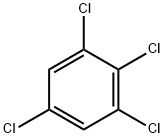Reactivity Profile
Simple aromatic halogenated organic compounds, such as 1,2,3,5-Tetrachlorobenzene , are very unreactive. Reactivity generally decreases with increased degree of substitution of halogen for hydrogen atoms. Materials in this group may be incompatible with strong oxidizing and reducing agents. Also, they may be incompatible with many amines, nitrides, azo/diazo compounds, alkali metals, and epoxides. 1,2,3,5-Tetrachlorobenzene may react with oxidizers. .
Environmental Fate
Biological. A mixed culture of soil bacteria or a Pseudomonas sp. transformed 1,2,3,5-tetrachlorobenzene
to 2,3,4,6-tetrachlorophenol (Ballschiter and Scholz, 1980). The half-life of 1,2,3,5-
tetrachlorobenzene in an anaerobic enrichment culture was 1.8 d (Beurskens et al., 1993).
In an enrichment culture derived from a contaminated site in Bayou d’Inde, LA, 1,2,3,5-
tetrachlorobenzene underwent reductive dechlorination to 1,2,4- and 1,3,5-trichlorobenzene at
relative molar yields of 7 and 93%, respectively. The maximum dechlorination rate, based on the
recommended Michaelis-Menten model, was 94 nM/d (Pavlostathis and Prytula, 2000).
Photolytic. Irradiation (λ ≥285 nm) of 1,2,3,5-tetrachlorobenzene (1.1–1.2 mM/L) in an
acetonitrile-water mixture containing acetone (0.553 mM/L) as a sensitizer gave the following
products (% yield): 1,2,3-trichlorobenzene (5.3), 1,2,4-trichlorobenzene (4.9), 1,3,5-trichlorobenzene
(49.3), 1,3-dichlorobenzene (1.8), 2,3,4,4′,5,5′,6-heptachlorobiphenyl (1.41), 2,2′,3,4,4′,6,6′-
heptachlorobiphenyl (1.10), 2,2′,3,3′,4,5′,6-heptachlorobiphenyl (4.50), four hexachlorobiphenyls
(4.69), one pentachlorobiphenyl (0.64), trichloroacetophenone, 1-(trichlorophenyl)-2-propanone,
and (trichlorophenyl)acetonitrile (Choudhry and Hutzinger, 1984). Without acetone, the identified
photolysis products (% yield) included 1,2,3-trichlorobenzene (trace), 1,2,4-trichlorobenzene
(24.3), 1,3,5-trichlorobenzene (11.7), 1,3-dichlorobenzene (0.5), 1,4-dichlorobenzene (3.3),
pentachlorobenzene (1.43), 1,2,3,4-tetrachlorobenzene (5.99), two heptachlorobiphenyls (1.40),
two hexachlorobiphenyls (<0.01), and one pentachlorobiphenyl (0.75) (Choudhry and Hutzinger,
1984).




